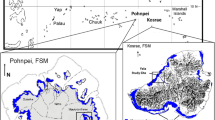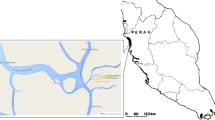Abstract.
Mangrove partitioning and storage of macronutrients and trace metals were examined in different arid coastal settings of Western Australia. Total living biomass in three Rhizophora stylosa forests, which ranged from 233 to 289 t DW ha–1, was significantly greater than biomass in three Avicennia marina forests (range: 79–155 t DW ha–1). Although prop roots and stems were the largest single tree components for R. stylosa and A. marina, respectively, most nutrients were stored in leaves and living roots of both species. However, only a small fraction of the total nutrient pool was vested in tree biomass; the vast bulk was in soils. A large below-ground pool of dead fine roots was identified at all stands, equivalent to 36–88% DW of total living tree biomass. The amount of Ca, S, Cl, Na, Si, Fe, Mn, Zn, B, Mo and Cu vested in dead roots of both species was greater than in the total living tree biomass. The proportion of Fe and S vested in live and dead roots was exceptionally large, consistent with previous evidence of metal plaques on mangrove roots. Sulphur, iron and zinc in dead roots of both species constituted the bulk of these metals. R. stylosa trees preferentially accumulated more Mg, S, Cl, Na, Si, Fe, Mn, B and Mo than A. marina trees. Proportionally greater storage of P, N, Ca, K, Cu and Zn occurred in two of the three A. marina forests. Foliar concentrations of Mg, S, Mn, B and Mo in mangrove leaves were at the high end of the range reported for other tropical trees, but other elemental concentrations were at the low or mid-range. Nitrogen limitation in these forests is implied by a positive correlation between total tree N and net canopy production and by a lower percentage of ecosystem N in tree biomass as compared with other forests. Unlike terrestrial forests where a large proportion of nutrient capital is vested in floor litter, most elements in these mangrove forests are stored in dead roots. A large reservoir of dead roots below the forest floor may serve as a conservation mechanism, particularly in such arid oligotrophic environments.
Similar content being viewed by others
Author information
Authors and Affiliations
Additional information
Electronic Publication
Rights and permissions
About this article
Cite this article
Alongi, D.M., Clough, B.F., Dixon, P. et al. Nutrient partitioning and storage in arid-zone forests of the mangroves Rhizophora stylosa and Avicennia marina . Trees 17, 51–60 (2003). https://doi.org/10.1007/s00468-002-0206-2
Received:
Accepted:
Issue Date:
DOI: https://doi.org/10.1007/s00468-002-0206-2




